Input interpretation

trichloroethylene
Chemical names and formulas
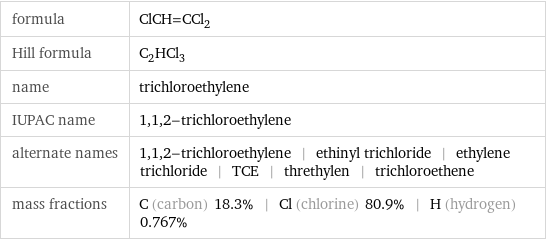
formula | ClCH=CCl_2 Hill formula | C_2HCl_3 name | trichloroethylene IUPAC name | 1, 1, 2-trichloroethylene alternate names | 1, 1, 2-trichloroethylene | ethinyl trichloride | ethylene trichloride | TCE | threthylen | trichloroethene mass fractions | C (carbon) 18.3% | Cl (chlorine) 80.9% | H (hydrogen) 0.767%
Lewis structure

Draw the Lewis structure of trichloroethylene. Start by drawing the overall structure of the molecule, ignoring potential double and triple bonds: Count the total valence electrons of the carbon (n_C, val = 4), chlorine (n_Cl, val = 7), and hydrogen (n_H, val = 1) atoms: 2 n_C, val + 3 n_Cl, val + n_H, val = 30 Calculate the number of electrons needed to completely fill the valence shells for carbon (n_C, full = 8), chlorine (n_Cl, full = 8), and hydrogen (n_H, full = 2): 2 n_C, full + 3 n_Cl, full + n_H, full = 42 Subtracting these two numbers shows that 42 - 30 = 12 bonding electrons are needed. Each bond has two electrons, so in addition to the 5 bonds already present in the diagram add 1 bond. To minimize formal charge carbon wants 4 bonds. Identify the atoms that want additional bonds and the number of electrons remaining on each atom: Fill in the 1 bond by pairing electrons between adjacent highlighted atoms: Answer: | |
3D structure
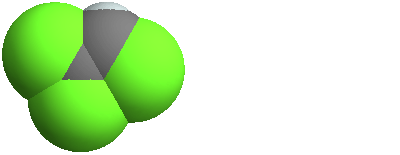
3D structure
Basic properties
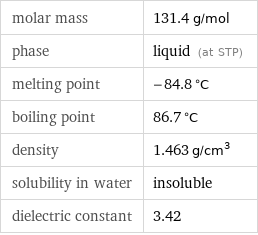
molar mass | 131.4 g/mol phase | liquid (at STP) melting point | -84.8 °C boiling point | 86.7 °C density | 1.463 g/cm^3 solubility in water | insoluble dielectric constant | 3.42
Liquid properties (at STP)
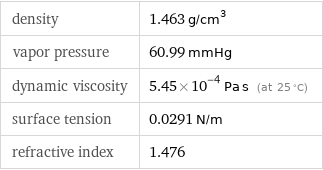
density | 1.463 g/cm^3 vapor pressure | 60.99 mmHg dynamic viscosity | 5.45×10^-4 Pa s (at 25 °C) surface tension | 0.0291 N/m refractive index | 1.476
Units

Thermodynamic properties
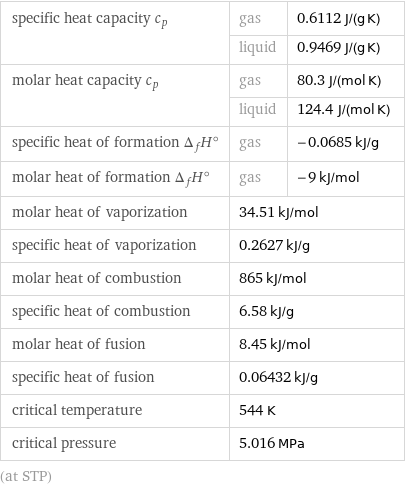
specific heat capacity c_p | gas | 0.6112 J/(g K) | liquid | 0.9469 J/(g K) molar heat capacity c_p | gas | 80.3 J/(mol K) | liquid | 124.4 J/(mol K) specific heat of formation Δ_fH° | gas | -0.0685 kJ/g molar heat of formation Δ_fH° | gas | -9 kJ/mol molar heat of vaporization | 34.51 kJ/mol | specific heat of vaporization | 0.2627 kJ/g | molar heat of combustion | 865 kJ/mol | specific heat of combustion | 6.58 kJ/g | molar heat of fusion | 8.45 kJ/mol | specific heat of fusion | 0.06432 kJ/g | critical temperature | 544 K | critical pressure | 5.016 MPa | (at STP)
Chemical identifiers
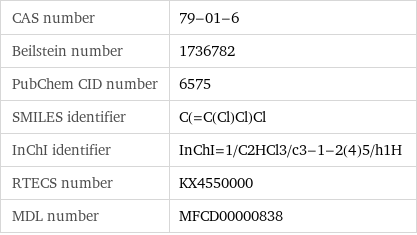
CAS number | 79-01-6 Beilstein number | 1736782 PubChem CID number | 6575 SMILES identifier | C(=C(Cl)Cl)Cl InChI identifier | InChI=1/C2HCl3/c3-1-2(4)5/h1H RTECS number | KX4550000 MDL number | MFCD00000838
NFPA label

NFPA label
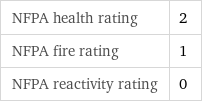
NFPA health rating | 2 NFPA fire rating | 1 NFPA reactivity rating | 0
Safety properties
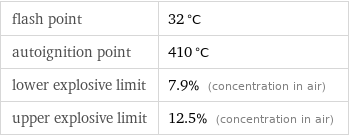
flash point | 32 °C autoignition point | 410 °C lower explosive limit | 7.9% (concentration in air) upper explosive limit | 12.5% (concentration in air)

DOT hazard class | 6.1 DOT numbers | 1710
Toxicity properties
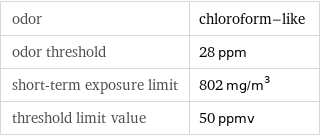
odor | chloroform-like odor threshold | 28 ppm short-term exposure limit | 802 mg/m^3 threshold limit value | 50 ppmv

long-term exposure limit | 535 mg/m^3 (over 8 hours) RTECS classes | agricultural chemical and pesticide | tumorigen | drug | mutagen | reproductive effector | human data | primary irritant